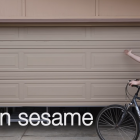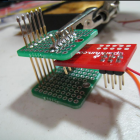EEtwidget
Member Since: January 17, 2013
Country: United States
-
Use the pin to toggle a FET, that way the FET is sinking/sourcing the current, not the ucontroller
-
Very nice, I like that this is a one wire device with the controller built in. I have the perfect application for this SMD rgb.
-
A simple project, flexible arduino ( kind of) http://www.elektor.com/news/a-really-flexible-microcontroller.2491753.lynkx .. American Semiconductor is making flex ucontrollers. 8-bit RISC, i2c, UART, SPI... Great for wearable projects. I have more ideas but I'm on my honeymoon so ya.. I shouldn't even be here posting :)
-
This is a very cool project but I find myself criticizing your soldering. Not to sound like a jerk, but whiskey tango foxtrot? Here is just one of many great soldering tutorial on youtube. http://www.youtube.com/watch?v=I_NU2ruzyc4
Not sure if they cover tinning wires, but you never apply the solder to the iron and use it to tin. If you do that, your burning away the flux from the solder core before it is effective. Instead, heat the wire, apply solder to the wire and tip to initiate heat transfer,then only apply solder to the wire. Stop the process before the solder reaches the wire insulation! If solder wicks, (enters the installation)your going to have a brittle joint.
Again, nice project. Just a little helpful (I hope) criticism.
nicholas
-
Wow, come on sparkfun. The Brass wire sponge does not go in the back! Fail, you even made the new product video with it in the back.
It's true that when your done soldering you should tin your tip, this ensures no oxidation is formed, however, you would never want to rest your tip in the sponge.
The sponge goes in the little opening below the iron, so put it there!
-
I used this with a PIC microcontroller but the hardware hook up should be the same for arduino.
There are two modes that this sensor works in. You can use it in PWM mode or I2C. I2C is the preferred method. You decide on the mode by address the sensor, so by default it's ready to go in I2C mode.
The sensor has 4 pins. The VSS (Ground), VDD (+5v), SDA (Data), and SCL (Clock). When using the sensor in PWM mode, SDA becomes PWM, and SCL becomes VZ.
You need to connect VSS to ground and VDD to +5 vdc. Be sure to use a filtering cap on the power pins of the sensor (0.1uF).
SDA and SCL need pull up resistor, a value of about 2.2k should work. If you leave them floating, (no pull up resistor), your data will be corrupt.
Code is provided above for arduino so I wont go too in-depth into the process but generally what your doing is using a modified I2C Bus, sending out the devices address to read from, then processing the data and doing something with it.
The device can return two values. It can return the target temperature, that is the temp the IR sees, and it can return the devices internal temp. This extra value, the devices temp, is handy when offsetting for ambient temperatures.
You will not be able to see a voltage on your scope like with an LM34/35, this sensor is much more sophisticated and therefore, harder to setup. But ones everything is setup.. it really is easy to use
-
I first saw this on Facebook, I am planning a wedding and I might just have to copy some of Bill's great ideas. Congratulations!
-
I'm having the sam problems with the bigger battery. Adding a load resistor should work, but its also a waste of power and you might need to heatsink. Till I have time to open this thing up I just plug my phone into one of the open ports to charge. That draws enough current to keep the battery on. I use the second port to power my project.
-
Sparkfun, can you hook up a decade box and let me know what the min "no load" shutoff is. I'm having trouble powering my digital projects.
No public wish lists :(








